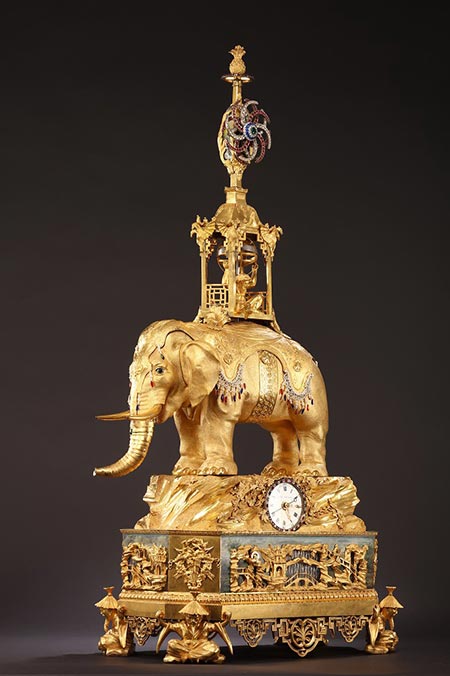 |
|
The 18th-century gilded-bronze chime clock by a British craftsman will go under the hammer on Monday. Photo provided to China Daily |
An 18th-century British clock, once kept at a Chinese royal court, is among a dozen antiquities that will be sold at a night auction on Dec 7 in Beijing.
At a height of 1.02 meters, the gilded-bronze chime clock exemplifies British clock-making techniques during the reign of George III (1738-1820). The timepiece, manufactured by craftsman Peter Torckler around 1780, was custom-made to meet the artistic demands of a Qing Dynasty (1644-1911) royal court.
The clock, which will go under the hammer in Poly Auction's saleroom, features both an intricate appearance and complicate design.
It is an assembly of five parts, and the base is a music box which sits on four legs, each sculpted into a Chinese man. The music box is embossed with landscapes and has four "shui fa (waterworks)" fountain designs.
On top of this is another pedestal that looks like a gold mountain. Inside this is the timing mechanism. It has a dial on one side and on the other side is a music plate which shows six compositions the clock can play.
Standing on the pedestal is an elephant, with a pavilion on its back.
This design symbolizes the Chinese idiom tai ping you xiang meaning "peace and affluence".
The clock also introduces Western art and science to its future Chinese owner.
A sculpture inside the pavilion portrays Atlas, the divine being who holds up the sky in Greek mythology, holding an ecliptic armillary sphere.
At the turn of every three hours, the fountains, the sphere and the flower designs at the top rotate, synchronizing with the elephant's moving body including its nose, eyes, ears and tail.
The clock revealed an interesting side of "timepiece diplomacy" between the East and the West at the time, says Li Yizhou, the general manager of Poly's Chinese ceramic arts unit.
He says the introduction of Western timepieces to China marked historic moments in the exchange of the two cultures, over a period of six centuries from the Ming (1368-1644) to the Qing dynasties.
Italian priest Matteo Ricci presented a chime clock to Emperor Wanli in 1600. Nearly 200 years later, a British diplomatic corps led by George Macartney presented a musical clock to Emperor Qianlong.
"Clocks became common in China's imperial palaces, and were beloved by the rulers," Li adds. "The Western world found these timepieces a key to the door of the Middle Kingdom."
He says Beijing's Palace Museum houses two similar gilded-bronze British clocks from the 18th century: One is an elephant pulling an European chariot and the other is an elephant carrying on its back a clock in the shape of pipa, a four-stringed Chinese musical instrument.
For some reason, the former clock was taken back to its place of origin.
It was later acquired by Naser al-Din Shah Qajar, the King of Persia (1948-96) during his visit to London in 1890.
It then remained with the Pahlavi Dynasty before being sold again to a British collector in 1925.
|
|
|
|
|
|
|
|
